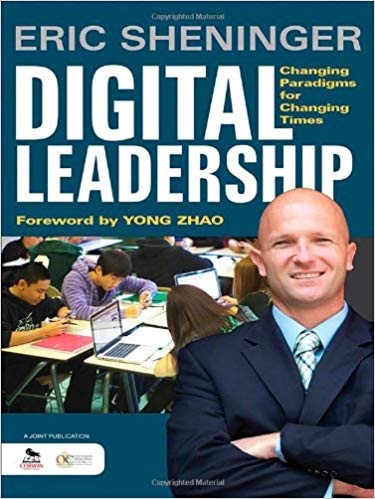
Digital Leadership: Changing Paradigms for Changing Times by Eric Sheninger explains how digital leadership is a strategic mindset and set of behaviors that leverage modern technology resources to improve a school’s culture. It will help educational leaders use social media and Web 2.0 tools to engage students, communicate with the community, and improve professional development at no marginal cost.
The Evolving Landscape
- Eric starts with a warning that if schools don’t adapt to take advantage of the technology students are growing up with, they run the risk of becoming meaningless and irrelevant. He provides a description of what each of these technologies are along with how they can be used to promote learning. He also notes today’s digital learners have many preferences that are at odds with those of the more traditional teachers many still face. They expect to access information quickly, work on several things at once, network and collaborate frequently, they often prefer other media to text, and they want learning to be relevant, active, useful, and fun. Eric also notes that technologies have been overhyped in the past and often look like solutions in search of problems. He challenges the readers to work with him to find the best ways to use the new technologies that our students live with outside of the classroom.
Why Change?
- Everything has changed except schools. Most schools still operate the way they did when they were invented to produce factory workers. Teachers do most of the talking and expect students to memorize what they see as important, and draw on material from a set-in-stone curriculum. Recent reforms are driven by the public and political sectors that feature one-size-fits-all testing just makes things worse. Even the addition of technology has not produced the needed change in pedagogy.
- What is needed are more lessons that require critical thinking, problem-solving, and the demonstration of learning through the creation and analysis of media. This will allow students to put their work on a blog for others to see. This change process can be messy and requires that teachers give up some control. Feedback from students is important here. Schools should add online courses, online field trips, independent study, credit for learning experiences outside of school, and internships. Leaders need to model technology use, support risk-takers, and make sure the staff has access. You can start the change process by having the staff read the free report Expanding Approaches for Learning in a Digital World.
Leading Sustainable Change
- Dr. Spike Cook, an elementary principal, modeled the use of technology for learning and communication for his staff. He rewarded teachers who took risks to follow his lead. As time went by he noticed increased technology use during his observations as many teachers joined him in the social media world.
- Eric summarizes Michael Fullan’s Six Secrets of Change. They include loving your employees, connecting peers, building capacity, and making learning central to all work and interactions. He then warns about the many roadblocks to sustaining transformative change. They include change is hard, lack of time, Lack of collaboration, too much top-down direction, lack of support, negative attitudes, fear, and poor professional development.
How New Milford High Changed
- Here Eric tells the story of how his high school went from ordinary to award-winning. The first change was his own philosophical enlightenment regarding the difference Web 2.0 tools and social media could make. He proceeded to educate himself and his staff. Encouragement, support, flexibility, and modeling were his key efforts. Next, he turned his students loose to help transform the culture. They were granted access to the school’s wireless network with their own devices. Such BYOD programs require a sense of trust that they will use their devices as learning tools. Finally, as innovative practices increased, he felt it was important to share what was taking place within and beyond the walls.
DrDougGreen.com If you like the summary, buy the book





